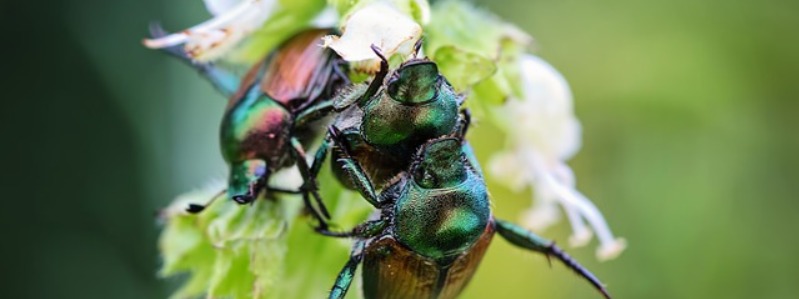List of different types of beetles in Texas.
Contents
Beetles are insects that stand apart for their toughness. Thick outer skeletons and body structures that make them look like bulldozers or tanks, and the resilience to face up to whatever the weather throws at them make them truly remarkable creatures indeed.
Beetles seem to love humans. They seem to follow us wherever we go: our houses, our barns, our silos, our warehouses, practically everywhere. If you have beetles in your home then you should try not to panic. Although most beetles are considered pests especially when they show up uninvited into farms and houses, Beetles are probably attracted to your house for the same reason as other creatures-food. They mostly go after grains that are kept in storage, and if not controlled, they can cause losses to farmers, merchants, and homeowners. In this article, we want to learn about some of the types of beetles that you can find in the state of Texas. Here we provide some identification tips to help you determine what type of beetle you have as tenants on your property as well as the dangers these beetles can pose to you, your family and your customers. We also give you some tips to evict them.
Types Of Beetles In Texas
-
1. Red Flour Beetle – Tribolium castaneum
The red flour beetle is one of the beetles in the species called Tenebrionidae, also called the darkling beetles. It is a beetle that troubles people worldwide once they have stored products, particularly food grains like rice, wheat, peas (called beans in some countries), and millets. This species of beetle is a major focus for ethological and food safety research. As their name implies, they mostly infest flour, although they will also feed on whole kernels or whole grains. This species of beetle will not cause any physical harm to humans, but they can contaminate stored food with their bodies, and also they add a bad odor and flavor to the flour they infest.
You can Recognize them By:
They have dark brownish or red bodies. Their bodies are flat without any prominent features. As for size, they are small; the adult red flour beetle measuring about 1/8 of an inch in length, and not forgetting their distinctive dark-brown or red color. They have two antennae on their heads that have three segments each. These beetles have wings, but they only use them sparingly and usually fly only very short distances. If you find beetles in your stored flour its probably them.
-
2. Confused Flour Beetle
The confused flour beetle is a cousin of the Red flour beetle- they are both darkling beetles. The Confused flour beetle is a common pest insect that is well known for attacking and infesting stored flour and also grains such as wheat, corn, millet and so on. They are one of the most common and most destructive types of beetles or any insect for that matter that are pests for grain and other food products that are stored in silos, warehouses, and grocery stores, even homes.
You Can Recognize them by:
The Confused flour beetle is very similar to the red flour beetle- after all, they are cousins. They have flattened, reddish-brown bodies that typically measure about 1/8 of an inch in length. The difference is that they may appear shiny, have grooved wing covers that have punctures dotted over them. Interestingly, both the confused flour beetle and the red flour beetle can be found together in stored foods items such as dried fruits and nuts, grains, legumes like beans and peanuts, and other products.

-
3. Boll Weevil
The boll weevil is another popular (notorious, actually) type of beetle. This type of beetle gained its infamy for being a serious pest of plants and stored products. The cotton boll weevils feed on cotton buds and flowers. Since cotton boll weevils came into the United States in 1892, they have caused billions of dollars in damage to the US cotton industry. Rice boll weevils, on the other hand, are known for destroying stored products such as rice, wheat, corn.
How to recognize them:
Boll Weevils are small grayish or reddish-brown beetles. They are a little bigger than the two we have highlighted earlier, measuring in around ¼ of an inch in length.
-
4. June Bug
June Bugs, also called June beetles, are small beetles that emerge (into adulthood) in the spring (hence their name) and they will fly into homes because they are attracted by lights. In nature, the larval stage of these brown beetles feeds on grass, although they can sometimes destroy the roots and cause the grass to turn yellow and die. These pests are just a nuisance in and around homes. They are just attracted to lights, and cannot harm you, your kids, or your pets. Please do not panic, and there is absolutely no reason to make frantic calls to the pest control experts on their account. Just make sure that they are really June bugs, and when you are sure, then there is no problem. You must be asking ‘how can I identify June bugs so I know exactly what I am dealing with?’ We tell you exactly that in Paragraph below.
How to Recognize Them:
June Bugs are bigger than any of the beetles that we have highlighted so far, measuring between ½ an inch and 5/8 of an inch in length. They are a reddish-brown or pure brown in color and have smooth bodies.
How to Avoid Beetles in Your Home
- At the store, only purchase food items that have seals that are completely intact; if there is a hole or rip in packaging, do not buy the product.
- Store food items that come in soft packing inside hard plastic or glass containers with covers or lids that fit tightly.
Keep the areas where you store food items secure. Make sure that doors and windows are intact, and seal all crevices.
What To Do When You Find Beetles In Your Home:
If you spot any signs of stored product pests in your home, put the affected product in the freezer to contain the infestation. After that, you should then dispose of it outside your home once the food items (and the pests inside) have frozen.
You may change lighting around your home to sodium vapor lighting; these kinds of lights are less attractive to insects such as the June beetle. You can also choose to keep outdoor lights turned off at night and also to cover windows with blinds or shades to block out the light that attracts these unwanted house guests.
If the problem persists, or the numbers are frightfully high then Contact a pest control professional to do a sweep of your property, and also give you more tips to keep these insects away.
Conclusion On The Types Of Beetles In Texas:
Beetles are important members of the ecosystem. However, as they have been forced to share the same habitat as humans this often leads to a few clashes of interest. Beetles will often infest homes, barns, and stores for no other reason than the food which they find there. Other types of Beetles will only enter homes because they are attracted to the lights or for warmth during winter. If therefore you find beetles in your home, it is advisable to dispose of the food items and possibly contact a pest removal expert- depending on the level of infestation.

